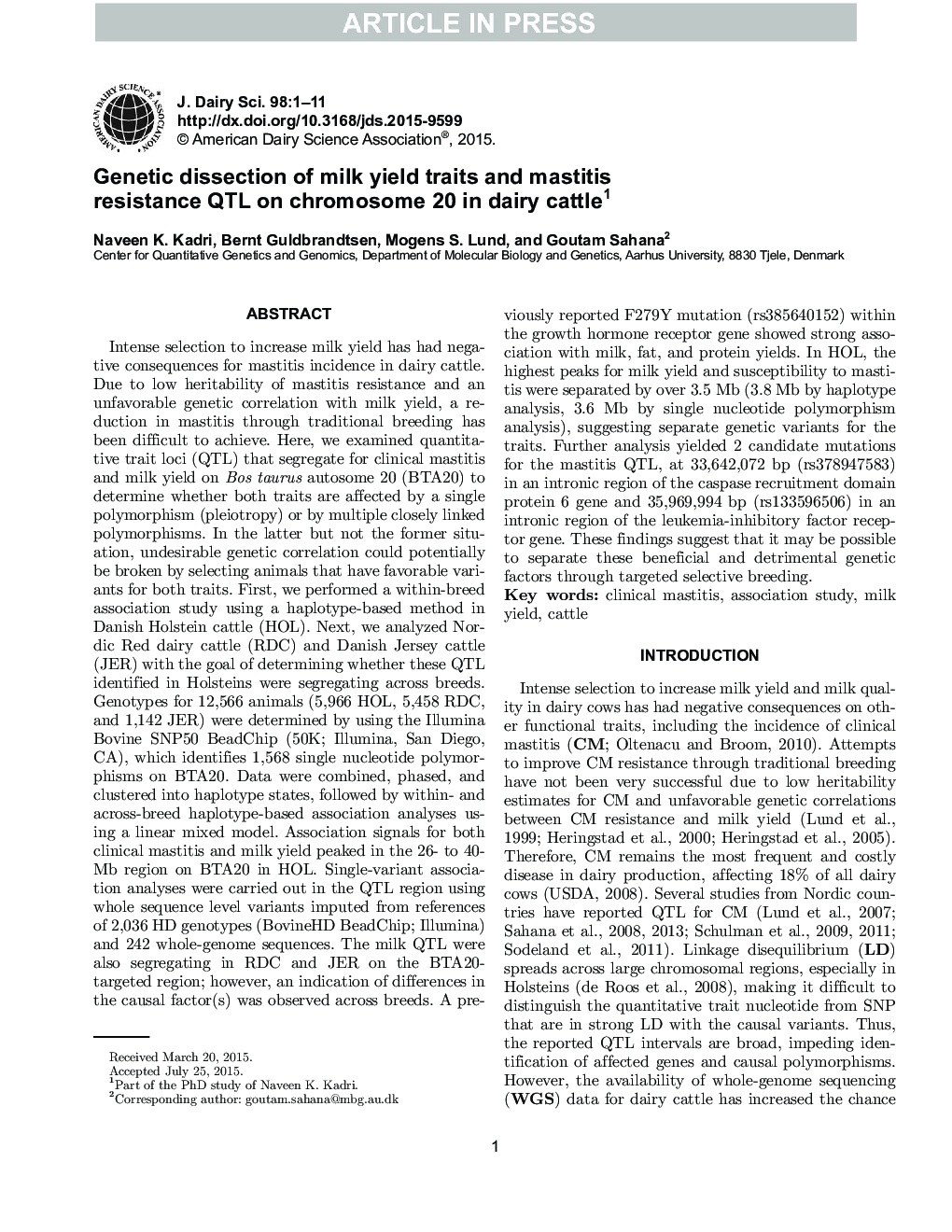| کد مقاله | کد نشریه | سال انتشار | مقاله انگلیسی | نسخه تمام متن |
|---|---|---|---|---|
| 10973436 | 1108014 | 2015 | 11 صفحه PDF | دانلود رایگان |
عنوان انگلیسی مقاله ISI
Genetic dissection of milk yield traits and mastitis resistance quantitative trait loci on chromosome 20 in dairy cattle1
ترجمه فارسی عنوان
جداسازی ژنتیکی صفات تولید شیر و ویژگی صفات کمینه مقاومت به ورم پستان در کروموزوم 20 در گاوهای شیری 1
دانلود مقاله + سفارش ترجمه
دانلود مقاله ISI انگلیسی
رایگان برای ایرانیان
کلمات کلیدی
ماستیت بالینی، مطالعه انجمن عملکرد شیر، گاو
موضوعات مرتبط
علوم زیستی و بیوفناوری
علوم کشاورزی و بیولوژیک
علوم دامی و جانورشناسی
چکیده انگلیسی
Intense selection to increase milk yield has had negative consequences for mastitis incidence in dairy cattle. Due to low heritability of mastitis resistance and an unfavorable genetic correlation with milk yield, a reduction in mastitis through traditional breeding has been difficult to achieve. Here, we examined quantitative trait loci (QTL) that segregate for clinical mastitis and milk yield on Bos taurus autosome 20 (BTA20) to determine whether both traits are affected by a single polymorphism (pleiotropy) or by multiple closely linked polymorphisms. In the latter but not the former situation, undesirable genetic correlation could potentially be broken by selecting animals that have favorable variants for both traits. First, we performed a within-breed association study using a haplotype-based method in Danish Holstein cattle (HOL). Next, we analyzed Nordic Red dairy cattle (RDC) and Danish Jersey cattle (JER) with the goal of determining whether these QTL identified in Holsteins were segregating across breeds. Genotypes for 12,566 animals (5,966 HOL, 5,458 RDC, and 1,142 JER) were determined by using the Illumina Bovine SNP50 BeadChip (50K; Illumina, San Diego, CA), which identifies 1,568 single nucleotide polymorphisms on BTA20. Data were combined, phased, and clustered into haplotype states, followed by within- and across-breed haplotype-based association analyses using a linear mixed model. Association signals for both clinical mastitis and milk yield peaked in the 26- to 40-Mb region on BTA20 in HOL. Single-variant association analyses were carried out in the QTL region using whole sequence level variants imputed from references of 2,036 HD genotypes (BovineHD BeadChip; Illumina) and 242 whole-genome sequences. The milk QTL were also segregating in RDC and JER on the BTA20-targeted region; however, an indication of differences in the causal factor(s) was observed across breeds. A previously reported F279Y mutation (rs385640152) within the growth hormone receptor gene showed strong association with milk, fat, and protein yields. In HOL, the highest peaks for milk yield and susceptibility to mastitis were separated by over 3.5 Mb (3.8 Mb by haplotype analysis, 3.6 Mb by single nucleotide polymorphism analysis), suggesting separate genetic variants for the traits. Further analysis yielded 2 candidate mutations for the mastitis QTL, at 33,642,072 bp (rs378947583) in an intronic region of the caspase recruitment domain protein 6 gene and 35,969,994 bp (rs133596506) in an intronic region of the leukemia-inhibitory factor receptor gene. These findings suggest that it may be possible to separate these beneficial and detrimental genetic factors through targeted selective breeding.
ناشر
Database: Elsevier - ScienceDirect (ساینس دایرکت)
Journal: Journal of Dairy Science - Volume 98, Issue 12, December 2015, Pages 9015-9025
Journal: Journal of Dairy Science - Volume 98, Issue 12, December 2015, Pages 9015-9025
نویسندگان
Naveen K. Kadri, Bernt Guldbrandtsen, Mogens S. Lund, Goutam Sahana,
